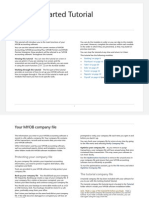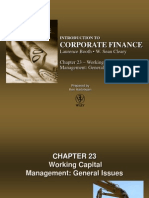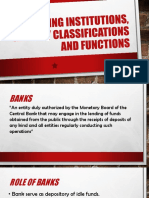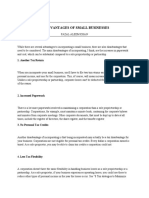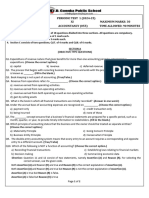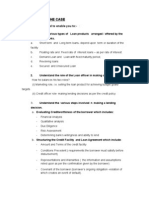0 ratings0% found this document useful (0 votes)
255 views3-Banking Financial Institution PDF
3-Banking Financial Institution PDF
Uploaded by
Yna AlejoBanks are financial institutions that accept deposits and channel them into lending activities. They connect customers with surpluses to customers with deficits. Banks perform key functions like accepting deposits, making loans, facilitating exchanges, and providing trust services. They are classified based on ownership, location, structure, and regulations. Major bank types include universal banks, commercial banks, thrift banks, rural/cooperative banks, and Islamic banks. The PDIC provides deposit insurance of up to 500,000 pesos per depositor to promote stability in the banking system. Banks must maintain reserves that are not lent out to meet depositors' needs.
Copyright:
© All Rights Reserved
Available Formats
Download as PDF, TXT or read online from Scribd
3-Banking Financial Institution PDF
3-Banking Financial Institution PDF
Uploaded by
Yna Alejo0 ratings0% found this document useful (0 votes)
255 views29 pagesBanks are financial institutions that accept deposits and channel them into lending activities. They connect customers with surpluses to customers with deficits. Banks perform key functions like accepting deposits, making loans, facilitating exchanges, and providing trust services. They are classified based on ownership, location, structure, and regulations. Major bank types include universal banks, commercial banks, thrift banks, rural/cooperative banks, and Islamic banks. The PDIC provides deposit insurance of up to 500,000 pesos per depositor to promote stability in the banking system. Banks must maintain reserves that are not lent out to meet depositors' needs.
Original Title
3-banking financial institution.pdf
Copyright
© © All Rights Reserved
Available Formats
PDF, TXT or read online from Scribd
Share this document
Did you find this document useful?
Is this content inappropriate?
Banks are financial institutions that accept deposits and channel them into lending activities. They connect customers with surpluses to customers with deficits. Banks perform key functions like accepting deposits, making loans, facilitating exchanges, and providing trust services. They are classified based on ownership, location, structure, and regulations. Major bank types include universal banks, commercial banks, thrift banks, rural/cooperative banks, and Islamic banks. The PDIC provides deposit insurance of up to 500,000 pesos per depositor to promote stability in the banking system. Banks must maintain reserves that are not lent out to meet depositors' needs.
Copyright:
© All Rights Reserved
Available Formats
Download as PDF, TXT or read online from Scribd
Download as pdf or txt
0 ratings0% found this document useful (0 votes)
255 views29 pages3-Banking Financial Institution PDF
3-Banking Financial Institution PDF
Uploaded by
Yna AlejoBanks are financial institutions that accept deposits and channel them into lending activities. They connect customers with surpluses to customers with deficits. Banks perform key functions like accepting deposits, making loans, facilitating exchanges, and providing trust services. They are classified based on ownership, location, structure, and regulations. Major bank types include universal banks, commercial banks, thrift banks, rural/cooperative banks, and Islamic banks. The PDIC provides deposit insurance of up to 500,000 pesos per depositor to promote stability in the banking system. Banks must maintain reserves that are not lent out to meet depositors' needs.
Copyright:
© All Rights Reserved
Available Formats
Download as PDF, TXT or read online from Scribd
Download as pdf or txt
You are on page 1of 29
Banking Institutions
CBA faculty combined notes from different references
Banking Institutions(Banks)
• Officially chartered institutions empowered to receive deposits, make
loans, and provide checking and savings account services, all at a
profit.
• a financial intermediary that accepts deposits and channels those
deposits into lending activities, either directly or through capital
markets. A bank connects customers with capital deficits to
customers with capital surpluses.
• financial institutions given the responsibility of accepting deposits
from the general public and lending these to those in need.
• an institution whose current operations consist of granting loans and
receiving deposits from the public
Bank Functions
1. Deposit function – receives demand deposits which can only be
withdrawn.
2. Loan Function – advances sums of money for relatively short periods of
time to persons engaged in commerce and trade
3. Exchange Function – refers to the transfer of funds without the physical
transfer of cash
4. Trust Function – fiduciary activities such as administrator of estates,
guardians of minor’s interest, registrars and transfer agents of stocks and
bonds, executors of last will and testaments.
5. Advisory Function – offers expert advice to clients on their business
dealings through the banks experienced officers
Classifications of Banks
1. As to ownership
• Private banks
• Public banks
2. As to place of incorporation
• Domestic
• Foreign
3. As to structure
• Stock
• Non-stock
Classifications of Banks
4. As to BSP MORB (Manual of Regulations for Banks)
• (BSP MORB-A compilation of banking regulations and policy issuances
of the Bangko Sentral ng Pilipinas (BSP). It is a convenient reference
and guide for banks in the conduct of their operations.)
A. Universal bank (UB)
B. Commercial bank (KB)
C. Thrift bank (TB)
D. Rural banks (RB)
E. Cooperative banks (CoopB)
F. Islamic Bank (IB)
A. Universal Bank
• A Universal Bank shall have the authority to exercise, in addition to
the powers and services authorized for a Commercial Banks and those
provided by other laws which are the following:
a. Power of an Investment House
b. Power to invest on non-allied enterprises
c. The power to own up to 100% of equity in a Thrift Banks, and Rural Banks,
and Financial Allied Enterprise,
d. The power to own up to 100% voting stock of only one other UB or KB
B. Commercial Bank
• Corporations engaged regularly in the lending of funds obtained from the
public through the receipt of deposits and which accept or create demand
deposits subject to withdrawal.
• Exercise the general powers incident to a corporation and carry the
business of a commercial bank such as:
a. accepting drafts
b. issuing letters of credit
c. discounting and negotiating promissory notes, drafts, bills of exchange, and other
evidences of debt
d. accepting or creating demand deposits;
e. receiving other types of deposits and deposit substitutes
f. buying and selling foreign exchange and gold or silver bullion
g. acquiring marketable bonds and other debt securities
B. Commercial Bank
• Corporations engaged regularly in the lending of funds obtained from the public
through the receipt of deposits and which accept or create demand deposits
subject to withdrawal.
• Exercise the general powers incident to a corporation and carry the business of a
commercial bank such as:
h. extending credit, subject to such rules as the Monetary Board may promulgate.
i. invest in the equities of allied enterprises
j. purchase, hold and convey real estate
k. receive in custody funds, documents and valuable objects
l. act as financial agent
m. make collections and payments for the account of others and perform such other services
for their customers
n. act as managing agent, adviser, consultant or administrator of investment management/
advisory/consultancy accounts
o. rent out safety deposit boxes
Financial Allied Undertakings
• Leasing companies including leasing of stalls and spaces in a commercial
establishments
• Investment houses
• Banks
• Financing companies
• Credit card companies
• Financial institutions catering to small and medium scale industries
including venture capital corporations
• Companies engaged in stock brokerage/securities dealership
• Companies engaged in foreign exchange dealership
Non-Financial Allied Undertakings
• Warehousing companies
• Storage companies
• Safe deposit box companies
• Companies primarily engaged in the management of mutual funds
• Companies engaged in providing computer services
• Insurance agencies
• Companies engaged in home building and home development
• Companies providing drying and/or milling facilities for agricultural
crops
C. Thrift Banks
• Established primarily to mobilize small savings and provide loans generally
longer and easier terms. They cater to small and medium enterprises.
• Services offered by Thrift Banks:
a. grant secured and unsecured loans
b. extend credit facilities to private and government employees
c. accepts savings and time deposits
d. accepts foreign currency deposits
e. act as a correspondent to other financial institutions
f. purchased, hold, and convey real estate.
g. open current or checking account
h. act as a collection agent for government agencies
i. act as official depository of national agencies and of municipal where the TB is
located
D. Rural Banks and E. Cooperative Banks
• Largely privately owned that provide credit facilities to farmers and
merchants or their cooperatives and in general, to the people of rural
communities.
• Services offered:
a. extend loans and advances primarily for the purpose of meeting the normal credit
needs of farmers, fishermen, cooperatives, merchants, private and public
employees
b. accepts savings and deposits
c. act as a collection agent
d. accepts current or checking accounts
e. act as trustee over estates or properties of farmers and merchants
f. act as official depository of municipal, city or provincial funds in the municipality,
city or province where it is located
E. Islamic Banks
• also known as non-interest banking, is a banking system that is based
on the principles of Islamic, or Shari'ah, law and guided by Islamic
economics.
• Two fundamental principles of Islamic banking are the sharing of
profit and loss and the prohibition of the collection and payment of
interest by lenders and investors. Islamic law prohibits collecting
interest or "riba."
Specialize Government Banks
• Banks organized by the government to serve a special purpose.
1. Development Bank of the Philippines
2. Land Bank of the Philippines
3. Al-Amanah Islamic Bank
Bank Credit Instruments
• Instruments offered to customers and use by banks to generate profit.
• Divisions of bank credit instruments
• Promises to pay(2 parties) • Orders to pay(3 parties)
• Promissory note • Bill of exchange
• Bank note • Check
• Bankers acceptance • Current account(NOW account)
• Letter of credit • Drafts
Money market instruments
• T-bills
• Negotiable certificate of deposits
• Commercial papers
Deposit Function
• Represented by money or representative of money but not limited to money entrusted
to banks for safekeeping
• Types of deposits
• Demand deposits
• Time deposits
• Kinds of depositors
• Individual
• Business
• Government
• Other banks
• Motives or reasons for deposits
• Safety
• Convenience
• Earnings/income
• Accommodation
Deposit Function
The Receiving Teller The Paying Teller
• Errors in counting the money deposited • Date of check
• Presence of counterfeit • Wrong endorsement
• Postdated checks • Material alteration
• Stale checks • Forgery
• Material alterations • Crossed checks
• Wrongly endorsed instruments • Stop-payment order
• Carelessness in adding deposit slips
• Insufficient funds
• Carelessness in designating account to be
credited • Erroneous payment
• The deposit slip • Supply of cash
The PDIC (Philippine Deposit Insurance
Corporation)
• PDIC is a government instrumentality created in 1963 by virtue of
Republic Act 3591, as amended, to insure the deposits of all banks.
• PDIC exists to protect depositors by providing deposit insurance
coverage for the depositing public and help promote financial stability
• Maximum Deposit Insurance for Each Depositor Php500,000
• Mandate
• PDIC exists to provide deposit insurance coverage for the depositing public to
help promote public confidence and stability in the economy. It ensures
prompt payment of insured deposits, exercises complementary supervision of
banks, adopts responsive resolution methods, and applies efficient
management of receivership and liquidation functions.
The PDIC (Philippine Deposit Insurance
Corporation) – Sample Computation Single
Account
The PDIC (Philippine Deposit Insurance
Corporation) – Sample Computation Single
Account
The PDIC (Philippine Deposit Insurance
Corporation) – Sample Computation Joint Account
The PDIC (Philippine Deposit Insurance
Corporation) – Sample Computation Joint Account
The Bank Reserves
• A bank reserve is the currency deposit which is not lent out to the
bank's clients.
• A small fraction of the total deposits is held internally by the bank in
cash vaults or deposited with the central bank.
• Minimum reserve requirements are established by central banks in
order to ensure that the financial institutions will be able to provide
clients with cash upon request.
Primary reserves
• Composition of primary reserves
• Cash in vaults
• Deposits to BSP
• Deposits to other banks
• Exchanges in the clearing house
• Checks for collection
Primary reserves
• Factors affecting size of primary reserves
• The number of depositors and the diversity of the business interests
• The confidence of the public in the bank
• The nature of the banks deposit
• The percentage of the legal reserve requirements
• The percentage and quality of the secondary reserves
• The demand for loans
• Habits and customs of the community
• Other factors
Secondary reserves
• Three important quality of secondary reserves
• High quality
• Short duration
• Must be marketable
• Composition of secondary reserves
• Short-term government securities
• Banker’s Acceptances
• Commercial papers issued by corporations with high credit ratings
• Short term loans
• Size of secondary reserves(no absolute rule, depends on the bank)
Investment Reserves
• What are eligible for investment reserves
• Stocks
• Bonds
• Other long term investments
Loan Function
• Types of loans
• As to purpose(agricultural, industrial, personal, housing, car, educational)
• As to maturity(long term, intermediate term, short term)
• As to security(secured, unsecured)
• As to method of payment(self-liquidating, non-self-liquidating) or (lump sum,
installment)
• As to method or release(Lump sum, installment)
• As to source
Trust Function
• The process the trustor, grantor, donor, testator transfers the title of
the property to a trustee for the benefit of the beneficiary, wherein
the trustee practices the prudent man principle.
You might also like
- Screenshot 2020-04-10 at 10.10.12 A PDFDocument4 pagesScreenshot 2020-04-10 at 10.10.12 A PDFRichard VarnadoNo ratings yet
- MYOB TutorialDocument46 pagesMYOB TutorialChai Koh LongNo ratings yet
- Walmart Moneycard Bank StatementDocument2 pagesWalmart Moneycard Bank StatementClifton Wilson50% (2)
- Group 3 Understanding Cooperative Bookkeeping and Financial StatementsDocument28 pagesGroup 3 Understanding Cooperative Bookkeeping and Financial Statementschristian romar dacanay100% (1)
- Financial Accounting and ReportingDocument8 pagesFinancial Accounting and ReportingJulieta Bucod CutarraNo ratings yet
- BSA2A WrittenReports Thrift-BanksDocument5 pagesBSA2A WrittenReports Thrift-Banksrobert pilapilNo ratings yet
- Commercial BankDocument25 pagesCommercial Bankcj.terragoNo ratings yet
- Thrift Banks and Rural BanksDocument14 pagesThrift Banks and Rural BanksrowelmanigbasNo ratings yet
- Collection Remedial ManagementDocument3 pagesCollection Remedial ManagementRachel Ann RazonableNo ratings yet
- 5 A Credit and Collection LetterDocument33 pages5 A Credit and Collection LetterEj AguilarNo ratings yet
- Cred&coll Reviewer MidtermsDocument24 pagesCred&coll Reviewer MidtermsElla Marie LopezNo ratings yet
- Credit & Receivables Ross Book SlidesDocument8 pagesCredit & Receivables Ross Book SlidesMohamed HamedNo ratings yet
- Bank and Banking PerspectiveDocument10 pagesBank and Banking PerspectiveDennilyn TanchicoNo ratings yet
- Universal BankDocument1 pageUniversal Bankhailene lorenaNo ratings yet
- 1 Concept of MoneyDocument6 pages1 Concept of MoneyKristel Imy Caldeo100% (1)
- Introduction - The Philippine Financial SystemDocument29 pagesIntroduction - The Philippine Financial Systembea nics100% (1)
- 4 - Unit II - Part 2 - Structure of The Philippine Financial SystemDocument8 pages4 - Unit II - Part 2 - Structure of The Philippine Financial SystemAlexis Ann Angan AnganNo ratings yet
- Chapter 3 CreditDocument2 pagesChapter 3 Creditcoleen100% (2)
- Overview of CreditDocument24 pagesOverview of CreditJanell AgananNo ratings yet
- Module III PDIC LawDocument10 pagesModule III PDIC LawChristine ViernesNo ratings yet
- Module 2 Credit - CollectionDocument14 pagesModule 2 Credit - CollectionAicarl JimenezNo ratings yet
- Chapter 4 Commercial BanksDocument33 pagesChapter 4 Commercial BanksChichay KarenJoyNo ratings yet
- Chapter 6 Bank OrganizationDocument22 pagesChapter 6 Bank OrganizationDeanne Lorraine V. GuintoNo ratings yet
- Deficit FinancingDocument14 pagesDeficit FinancingJonny Gayomey100% (1)
- Banking Financial Institutions - SyllabusDocument8 pagesBanking Financial Institutions - SyllabusLove RosalunaNo ratings yet
- 1 Module 7 Bangko Sentral NG Pilipinas-2Document3 pages1 Module 7 Bangko Sentral NG Pilipinas-2Nika Rose RazonNo ratings yet
- Credit and Collection For The Small Entrepreneur: By: John Xavier S. Chavez, MFMDocument46 pagesCredit and Collection For The Small Entrepreneur: By: John Xavier S. Chavez, MFMRheneir MoraNo ratings yet
- Development of Credit and Collection Policy PDFDocument35 pagesDevelopment of Credit and Collection Policy PDFJimuel Faigao100% (2)
- Monetary POLICYDocument21 pagesMonetary POLICYSrishti VasdevNo ratings yet
- Commercial BankDocument11 pagesCommercial BankVaibhavi BorhadeNo ratings yet
- FINMAR - Introduction To Financial Management and Financial MarketsDocument8 pagesFINMAR - Introduction To Financial Management and Financial MarketsLagcao Claire Ann M.No ratings yet
- Financial StatementDocument45 pagesFinancial StatementykaaNo ratings yet
- Credit and CollectionDocument11 pagesCredit and Collectionerikka june forosueloNo ratings yet
- Sources of Short-Term Funds: Construction GroupDocument54 pagesSources of Short-Term Funds: Construction GroupRia MendezNo ratings yet
- Chapter-5 Intermediate Term FinancingDocument11 pagesChapter-5 Intermediate Term FinancingTarek Monowar 1921659042No ratings yet
- Chapter-2: Audit of Cash and Marketable SecuritiesDocument27 pagesChapter-2: Audit of Cash and Marketable Securitiesbikilahussen100% (1)
- Ch3 Credit DepartmentDocument6 pagesCh3 Credit DepartmentWilsonNo ratings yet
- The Exchange FunctionDocument70 pagesThe Exchange FunctionJesah Christa Jaen MontañoNo ratings yet
- Module 4 - Credit InvestigationDocument37 pagesModule 4 - Credit InvestigationAllan Cris RicafortNo ratings yet
- Terms and Datings C6 C&CDocument13 pagesTerms and Datings C6 C&CAnGela OiswennNo ratings yet
- Module 2 - The Credit Manager & The Credit and Collection UnitDocument33 pagesModule 2 - The Credit Manager & The Credit and Collection UnitAllan Cris Ricafort100% (1)
- Fund ManagementDocument47 pagesFund Managementjanine mujeNo ratings yet
- Chapter 23 - Working Capital Management - General IssuesDocument86 pagesChapter 23 - Working Capital Management - General IssuesKamal Singh ChouhanNo ratings yet
- Introduction To FinanceDocument22 pagesIntroduction To FinanceJudil BanastaoNo ratings yet
- Chapter 3 SOURCES OF CREDITDocument20 pagesChapter 3 SOURCES OF CREDITmarcus vladNo ratings yet
- Credit ReviewDocument6 pagesCredit ReviewLouise Anne GiliNo ratings yet
- What Does Treasury Department Do in A Bank?Document12 pagesWhat Does Treasury Department Do in A Bank?Dolores RosarioNo ratings yet
- Credit SystemDocument57 pagesCredit SystemHakdog CheeseNo ratings yet
- Government Accounting (AFA-II) : Governmental Entities: Introduction and General Fund AccountingDocument8 pagesGovernment Accounting (AFA-II) : Governmental Entities: Introduction and General Fund AccountingMd. Rejaul Ahsan Chowdhury100% (1)
- Chapter 3Document38 pagesChapter 3akmal_07No ratings yet
- W1 Module 1 - Introduction To Financial ManagementDocument5 pagesW1 Module 1 - Introduction To Financial ManagementDanica VetuzNo ratings yet
- Financial System & BSPDocument46 pagesFinancial System & BSPZenedel De JesusNo ratings yet
- 8 Banker Customer Relationship PDFDocument20 pages8 Banker Customer Relationship PDFkhuram MehmoodNo ratings yet
- Completed Instructional Material Treasury ManagementDocument119 pagesCompleted Instructional Material Treasury ManagementGuya BanoNo ratings yet
- Banking Institutions History Classifications and FunctionsDocument13 pagesBanking Institutions History Classifications and FunctionsJessielyn GialogoNo ratings yet
- Cash Concentration EssayDocument2 pagesCash Concentration EssayPrincess Joy Andayan BorangNo ratings yet
- The Deposit FunctionDocument17 pagesThe Deposit FunctionNigel N. SilvestreNo ratings yet
- Fima30063-Lect1-Overview of CreditDocument24 pagesFima30063-Lect1-Overview of CreditNicole Lanorio100% (1)
- Anti Money Laundering SlidesDocument33 pagesAnti Money Laundering SlidesvalmadridhazelNo ratings yet
- Loan RestructuringDocument22 pagesLoan RestructuringNazmul H. PalashNo ratings yet
- Chapter 9: Credit Instruments ObjectivesDocument43 pagesChapter 9: Credit Instruments ObjectiveskatlicNo ratings yet
- Session 1 Money BSPDocument14 pagesSession 1 Money BSPMarria FrancezcaNo ratings yet
- Unit II - Functions of A BankDocument15 pagesUnit II - Functions of A BankML CreationsNo ratings yet
- Keerthi Reddy - CommodityDocument9 pagesKeerthi Reddy - CommodityMOHAMMED KHAYYUMNo ratings yet
- Small Businesses DisadvantagesDocument6 pagesSmall Businesses DisadvantagesFazal Aleem KhanNo ratings yet
- Financial Management RatiosDocument6 pagesFinancial Management RatiosCharlotte PalmaNo ratings yet
- Questionnaire: "A Study On Customer's Perception Towards Internet Banking in Rajkot City"Document4 pagesQuestionnaire: "A Study On Customer's Perception Towards Internet Banking in Rajkot City"jaykishanfefar100% (1)
- Periodic Test - 1 Xi AccDocument2 pagesPeriodic Test - 1 Xi AccchaudharysirphysicsNo ratings yet
- Amar Automotive PVT LTDDocument18 pagesAmar Automotive PVT LTDMitesh JainNo ratings yet
- Auctresults 1770Document1 pageAuctresults 1770Fuaad DodooNo ratings yet
- Dyuthi T0113Document290 pagesDyuthi T0113DavidNo ratings yet
- Dividend Policy Review QuestionsDocument3 pagesDividend Policy Review QuestionsAbdulkarim Hamisi KufakunogaNo ratings yet
- TORUS MLD - Pure Equity - July 23Document14 pagesTORUS MLD - Pure Equity - July 23Ashish Ranjan JhaNo ratings yet
- Inacct3 Module 3 QuizDocument7 pagesInacct3 Module 3 QuizGemNo ratings yet
- Beams Aa13e TB 22Document37 pagesBeams Aa13e TB 22Nazia EnayetNo ratings yet
- Note On Bank Loans-SummaryDocument7 pagesNote On Bank Loans-Summaryscbihari1186No ratings yet
- Assignment BGN 372Document6 pagesAssignment BGN 372Aliea NasreenNo ratings yet
- APP Lewis 2Document24 pagesAPP Lewis 2Hanako Laros RatuwangiNo ratings yet
- Call Money Market: Prof Mahesh Kumar Amity Business SchoolDocument23 pagesCall Money Market: Prof Mahesh Kumar Amity Business Schoolxpertshan100% (4)
- Mohawk Pto By-Laws Revised 2024 2Document7 pagesMohawk Pto By-Laws Revised 2024 2api-293638488No ratings yet
- Partner Bank Account Change Request KOYALSADocument1 pagePartner Bank Account Change Request KOYALSAPrabhat Kumar YadavNo ratings yet
- Cadel Soc 010924Document2 pagesCadel Soc 010924sekhjewel7No ratings yet
- UBL-24-Oct-2024 12 - 20 - 48Document7 pagesUBL-24-Oct-2024 12 - 20 - 48mashoodccwNo ratings yet
- Merchandising Business PDFDocument5 pagesMerchandising Business PDFJenny Valerie SualNo ratings yet
- Axis Bank Salary Account DeckDocument17 pagesAxis Bank Salary Account Deckkumarrodda69No ratings yet
- Acct Statement XX5742 09042024Document18 pagesAcct Statement XX5742 09042024harshilkarir72No ratings yet
- ANTI MONEY LAUNDERING ACT Case DigestsDocument7 pagesANTI MONEY LAUNDERING ACT Case DigestsRejzl Awit100% (1)
- SAS - HR - Written Test - AOS Senior (English)Document2 pagesSAS - HR - Written Test - AOS Senior (English)Rahman PrasetyoNo ratings yet
- The Forgotten Lessons of 2008 by Seth KlarmanDocument4 pagesThe Forgotten Lessons of 2008 by Seth KlarmanArgha PaulNo ratings yet
- Ffs EdfhcfDocument1 pageFfs EdfhcfPrasen RajNo ratings yet

